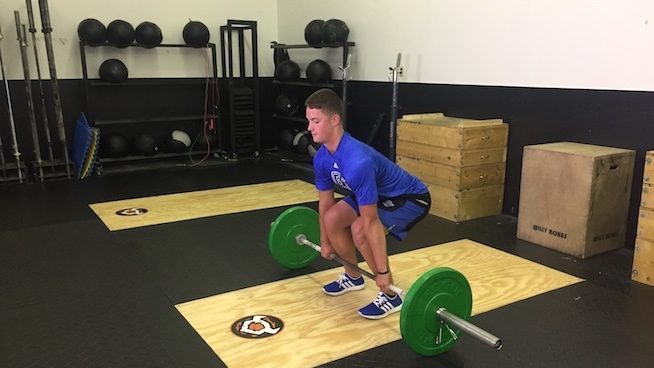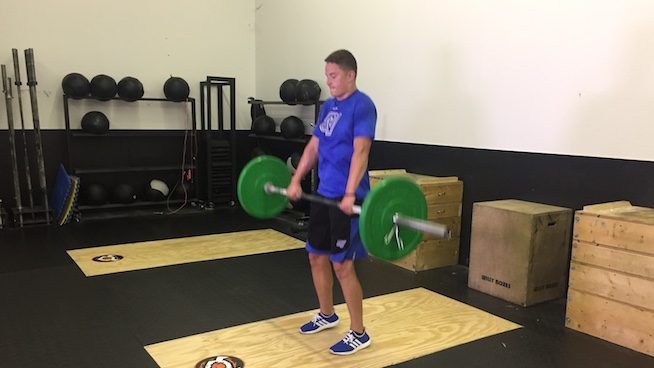Why the Clean Pull is Perfect for Athletes
Nearly every sport requires its athletes to be powerful.
To become more powerful, you must do two major things—improve your maximum force output and increase the rate at which you develop that force. In other words, the goal is high force developed quickly. You could take
In other words, the goal is high force developed quickly. You could take a long way around by addressing one training goal at a time (get bigger, get stronger, then get powerful); or, you can try to find an exercise that gives you the most bang for your buck.
You might think that heavy lifts are the way to go. Indeed, they are great for increasing maximum force output, but often are inadequate for developing power. On the flipside, plyometrics increase your rate of force development, but won’t do much for maximum force output.
So what’s the solution? Olympic lifting is the obvious answer.
Some people love Olympic lifting, and others despise it. Olympic lifts are one of the best types of exercises for developing explosive power. However, they’re difficult to learn, especially if you don’t have access to an Olympic lifting coach.
So, you may be wondering, “How can I reap the benefits of Olympic weightlifting without turning the bar over?” Again, the answer is simple.
Introducing the Clean Pull
The Clean Pull (from the floor) begins in the same manner as the Clean and Jerk or the Deadlift. You bend at the waist, keeping your back flat, grab the bar, pull it up, clearing your kneecaps, and begin to accelerate it. As you become more vertical, you drive your hips back and create contact with the bar at the mid-thigh level. Then, you pop into triple extension (hips forward, knees back and up on your toes). At the peak of the triple extension, the bar moves at maximum speed, and you shrug powerfully.
This highly explosive and athletic movement increases both Force Output and Rate of Force Development. And most important, it is a relatively simple lift, requires minimal equipment, and is supported by research. In my opinion, the Clean Pull is the king of power exercises for athletes. Check out the video above featuring strength coach Mike Anderson to learn how to perform it.
Step 1: Setup
Begin with the bar on the floor positioned close to your shins over your shoelaces. Stand with your feet hip-width apart, reach down and grab the bar with an overhand, shoulder-width grip.
Sit your butt down and stick your chest up. Pull your shoulder blades down and back and tighten your core. Your elbows should be rotated out to the sides with your arms completely straight. Look straight ahead.
Step 2: First Pull
Pull the bar off the floor by powerfully extending your legs, making sure to keep your back flat and your chest up. The bar should travel vertically in a straight line, not into you like during a Deadlift.
Step 3: Scoop and Second Pull
Once the bar is above your knees, shift your torso to a vertical position and rebend your knees slightly. This is the scoop.
Now initiate the second pull—the most powerful portion of the movement—by violently jumping straight up, fully extending your hips, knees and ankles (triple extension), while simultaneously shrugging your shoulders. Keep your elbows straight so the bar stays close to your body and doesn’t travel upward like during a Power Clean.
Step 4: Finish
Bend your hips and knees to absorb your momentum after completing the pull. Lower the bar to the ground as if performing the lowering phase of a Deadlift, and set up for your next rep. You can also drop the bar if you’re using bumper plates.
Common Clean Pull Form Mistake
Not engaging your back and core before a rep
It’s crucial that your back is not rounded during this lift. Engage your back and bring your shoulder blades down and back and tighten your core as if you’re about to take a punch. This ensures that your back and core are set and reduces your risk of injury.
Using a weight that’s too heavy
Remember, this exercise is about generating max force as quickly as possible. So if you find yourself grinding out reps like you would during a Deadlift, then it’s time to lighten the load.
Landing hard
Allow your knees and hips to bend slightly as your body (and the bar) begin to move downward after the shrug. This helps absorb your momentum and reduces stress on your joints.
Clean Pull Variations
Snatch Pull
This is the same exercise as the Clean Pull but with a snatch-grip. You can see this variation in action in the video above.
Hang Clean Pull
[youtube video=”GdoBxzBAuqE” /]Clean High Pull
[youtube video=”e-6dX2anRjg” /]
READ MORE:
Reference:
Tricoli, Valmor, Leonardo Lamas, Roberto Carnevale, and Carlos Ugrinowitsch. “Short-Term Effects on Lower-Body Functional Power Development: Weightlifting vs. Vertical Jump Training Programs.” Journal of Strength and Conditioning Research 19.2 (2005): 433. Web.
[cf]skyword_tracking_tag[/cf]RECOMMENDED FOR YOU
MOST POPULAR
Why the Clean Pull is Perfect for Athletes
Nearly every sport requires its athletes to be powerful.
To become more powerful, you must do two major things—improve your maximum force output and increase the rate at which you develop that force. In other words, the goal is high force developed quickly. You could take
In other words, the goal is high force developed quickly. You could take a long way around by addressing one training goal at a time (get bigger, get stronger, then get powerful); or, you can try to find an exercise that gives you the most bang for your buck.
You might think that heavy lifts are the way to go. Indeed, they are great for increasing maximum force output, but often are inadequate for developing power. On the flipside, plyometrics increase your rate of force development, but won’t do much for maximum force output.
So what’s the solution? Olympic lifting is the obvious answer.
Some people love Olympic lifting, and others despise it. Olympic lifts are one of the best types of exercises for developing explosive power. However, they’re difficult to learn, especially if you don’t have access to an Olympic lifting coach.
So, you may be wondering, “How can I reap the benefits of Olympic weightlifting without turning the bar over?” Again, the answer is simple.
Introducing the Clean Pull
The Clean Pull (from the floor) begins in the same manner as the Clean and Jerk or the Deadlift. You bend at the waist, keeping your back flat, grab the bar, pull it up, clearing your kneecaps, and begin to accelerate it. As you become more vertical, you drive your hips back and create contact with the bar at the mid-thigh level. Then, you pop into triple extension (hips forward, knees back and up on your toes). At the peak of the triple extension, the bar moves at maximum speed, and you shrug powerfully.
This highly explosive and athletic movement increases both Force Output and Rate of Force Development. And most important, it is a relatively simple lift, requires minimal equipment, and is supported by research. In my opinion, the Clean Pull is the king of power exercises for athletes. Check out the video above featuring strength coach Mike Anderson to learn how to perform it.
Step 1: Setup
Begin with the bar on the floor positioned close to your shins over your shoelaces. Stand with your feet hip-width apart, reach down and grab the bar with an overhand, shoulder-width grip.
Sit your butt down and stick your chest up. Pull your shoulder blades down and back and tighten your core. Your elbows should be rotated out to the sides with your arms completely straight. Look straight ahead.
Step 2: First Pull
Pull the bar off the floor by powerfully extending your legs, making sure to keep your back flat and your chest up. The bar should travel vertically in a straight line, not into you like during a Deadlift.
Step 3: Scoop and Second Pull
Once the bar is above your knees, shift your torso to a vertical position and rebend your knees slightly. This is the scoop.
Now initiate the second pull—the most powerful portion of the movement—by violently jumping straight up, fully extending your hips, knees and ankles (triple extension), while simultaneously shrugging your shoulders. Keep your elbows straight so the bar stays close to your body and doesn’t travel upward like during a Power Clean.
Step 4: Finish
Bend your hips and knees to absorb your momentum after completing the pull. Lower the bar to the ground as if performing the lowering phase of a Deadlift, and set up for your next rep. You can also drop the bar if you’re using bumper plates.
Common Clean Pull Form Mistake
Not engaging your back and core before a rep
It’s crucial that your back is not rounded during this lift. Engage your back and bring your shoulder blades down and back and tighten your core as if you’re about to take a punch. This ensures that your back and core are set and reduces your risk of injury.
Using a weight that’s too heavy
Remember, this exercise is about generating max force as quickly as possible. So if you find yourself grinding out reps like you would during a Deadlift, then it’s time to lighten the load.
Landing hard
Allow your knees and hips to bend slightly as your body (and the bar) begin to move downward after the shrug. This helps absorb your momentum and reduces stress on your joints.
Clean Pull Variations
Snatch Pull
This is the same exercise as the Clean Pull but with a snatch-grip. You can see this variation in action in the video above.
Hang Clean Pull
[youtube video=”GdoBxzBAuqE” /]Clean High Pull
[youtube video=”e-6dX2anRjg” /]
READ MORE:
Reference:
Tricoli, Valmor, Leonardo Lamas, Roberto Carnevale, and Carlos Ugrinowitsch. “Short-Term Effects on Lower-Body Functional Power Development: Weightlifting vs. Vertical Jump Training Programs.” Journal of Strength and Conditioning Research 19.2 (2005): 433. Web.
[cf]skyword_tracking_tag[/cf]












